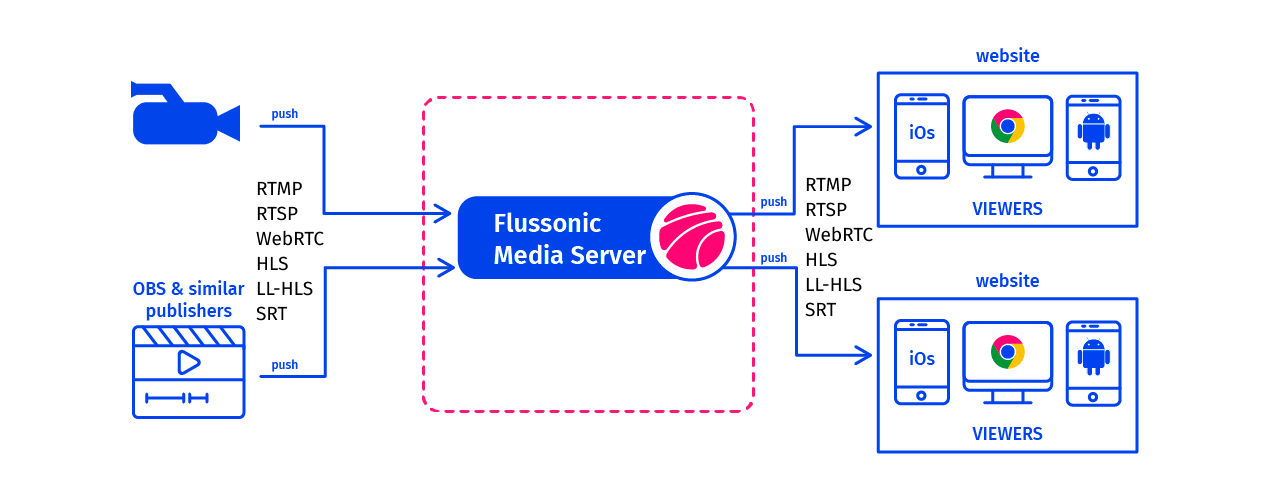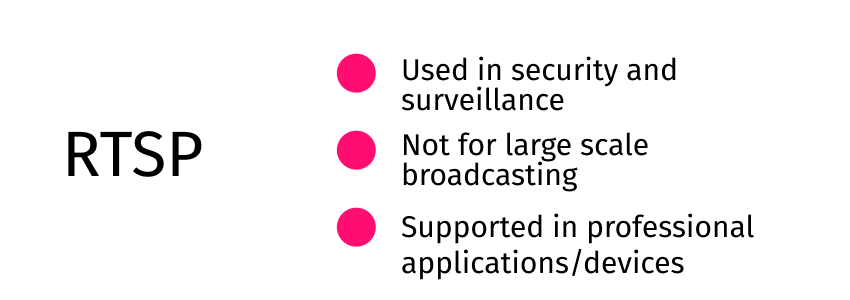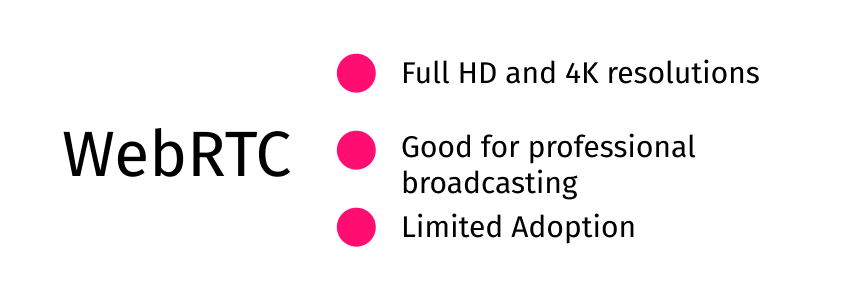RTMP, HLS, SRT, RTSP, and WebRTC: a comprehensive guide to video streaming protocols in 2024
The amount of time we spend watching videos is increasing every year. According to statista.com, more than 3 billion people watched online videos at least once a month. It’s safe to say that all of them expect high-quality, lag-free content. For broadcasters, bloggers, and production companies, choosing the right video transmission method is critical to keeping their audience engaged.
Popular streaming tools like OBS Studio, FFmpeg, and platforms such as YouTube Live and Facebook Live, utilize key protocols including RTMP, HLS, SRT, RTSP, and WebRTC. These protocols are widely supported across various devices and platforms, addressing diverse streaming needs from professional broadcasting to live streams by bloggers.
In this article, we explore the top video streaming protocols for 2024, focusing on their applications in professional video delivery. Whether you’re live streaming events, producing high-definition content, or managing corporate video communications, understanding these protocols is essential for optimizing your workflow.
Flussonic Media Server supports all these protocols, enabling efficient ingestion and reliable video streaming.

Top Video Streaming Protocols in 2024
Real-Time Messaging Protocol (RTMP)
RTMP, originally developed by Macromedia (and later acquired by Adobe), has been a cornerstone of live video streaming for over a decade. Designed to maintain persistent, low-latency connections, RTMP is particularly effective for live streaming scenarios where real-time delivery is critical. Although its popularity has diminished somewhat due to the decline of Adobe Flash, RTMP remains widely used for ingesting live video feeds into streaming platforms.
How RTMP works
RTMP works by breaking down the video stream into small packets, which are then transmitted over a persistent TCP connection. This method allows for minimal buffering and quick recovery from lost packets. Despite its effectiveness in live streaming, RTMP’s reliance on Flash for playback has become a limitation as modern devices and browsers have moved away from Flash support. However, RTMP continues to be a preferred protocol for server-to-server video transmission and is often used in conjunction with other protocols, such as HLS, for wider distribution.
Use Cases
RTMP is particularly valuable in scenarios where low latency is crucial, such as live news feeds or interactive broadcasts. Many streaming platforms, including YouTube Live and Facebook Live, support RTMP as an ingest protocol, allowing broadcasters to transmit high-quality video feeds from their encoders to the platform’s servers, where it is then distributed using more modern, adaptive streaming protocols.

HTTP Live Streaming (HLS)
Developed by Apple, HLS (HTTP Live Streaming) is one of the most popular streaming protocols today, widely used for delivering content to a variety of devices. HLS works by breaking down video content into small, HTTP-based file segments, allowing for adaptive bitrate streaming. HLS video ensures that viewers on different devices and networks can enjoy the best possible quality without interruption.
How it works
HLS works by dividing the video into small chunks and using an m3u8 playlist to index these segments. When a viewer requests the stream, the server delivers the appropriate segment based on the viewer’s current bandwidth and device capabilities. HLS’s adaptive bitrate streaming ensures that viewers on different devices and networks can enjoy the best possible quality without interruption. Although HLS traditionally had higher latency compared to protocols like RTMP or WebRTC, the introduction of Low-Latency HLS (LL-HLS) has addressed this issue.
Low-Latency HLS (LL-HLS): LL-HLS is an updated version of the traditional HLS protocol designed to significantly reduce latency, making it more suitable for live streaming applications where real-time interaction is critical. LL-HLS achieves this by reducing the segment size and using partial segments that can be delivered and played back before the entire segment is downloaded. This approach allows for latency to be reduced to as low as 2-3 seconds, making it competitive with other low-latency protocols like WebRTC and SRT. Apple’s support for LL-HLS on its devices has made it a popular choice for live sports, online auctions, and other time-sensitive streaming applications.
Use Cases
HLS video is widely used for video-on-demand (VOD) services and multi-platform streaming, where its adaptive bitrate streaming capabilities ensure a consistent viewing experience across diverse devices and network conditions. Major streaming services like Netflix, Hulu, and Amazon Prime utilize HLS, and many live streaming platforms are now adopting LL-HLS to enhance their real-time content delivery.

Secure Reliable Transport (SRT)
SRT is an open-source protocol designed by Haivision to deliver high-quality, low-latency video across unpredictable networks. SRT addresses many of the challenges associated with streaming over the public internet, such as packet loss, jitter, and fluctuating bandwidth. As an open-source protocol, SRT has quickly gained popularity in the broadcasting industry due to its reliability and ability to securely transport video streams.
How it works
SRT utilizes a combination of advanced error correction techniques and encryption to ensure that video is delivered securely and with minimal latency. One of its key features is the ability to transmit video at very high quality, including full HD and even 4K resolutions, making it ideal for professional broadcasts. SRT can dynamically adjust to network conditions, maintaining the integrity and high resolution of the stream, which is critical for broadcasts that require pristine video quality. SRT uses UDP as its transport layer, allowing for fast transmission, while its built-in recovery mechanism handles packet loss without requiring retransmission of the entire stream.
Use Cases
SRT is particularly well-suited for live event broadcasting, remote production, and any scenario where high-quality video—including high-resolution formats like 4K—needs to be transmitted over the public internet. Its secure and reliable nature, along with its ability to maintain high video quality and resolution, makes it a preferred choice for broadcasters like ESPN and NBC Sports, who use SRT to deliver live sports footage from remote locations to their central broadcast facilities.

Real-Time Streaming Protocol (RTSP)
RTSP (Real-Time Streaming Protocol) is a network control protocol designed for establishing and controlling media sessions between endpoints. Developed by RealNetworks, Netscape, and Columbia University, RTSP is widely used for streaming multimedia content such as audio and video over IP networks. It enables on-demand media streaming by allowing clients to remotely control the streaming server, akin to using remote control for playback operations like play, pause, and stop. Real-time streaming protocol is often employed in IP cameras, video conferencing systems, and streaming media servers.
How RTSP works
RTSP operates primarily as a control protocol that communicates between the client and server. It does not handle the actual transmission of media data, which is usually carried out by RTP (Real-Time Transport Protocol). The protocol functions by sending commands to the server, such as SETUP, PLAY, PAUSE, to manage the streaming session. These commands allow for precise control over the media stream, enabling functionalities like real-time streaming and recording. Real-time streaming protocol uses TCP for control messages.
Use Cases
RTSP is commonly used in scenarios where real-time control over streaming content is essential. It is widely implemented in IP security cameras, enabling users to access live video feeds, control pan-tilt-zoom (PTZ) functions, and manage recordings remotely. RTSP is also integral to video conferencing systems, providing real-time streaming and interaction capabilities between participants. Its ability to support complex streaming operations makes real-time streaming protocol a preferred choice for applications requiring reliable and controlled media delivery over IP networks.

WebRTC (Web Real-Time Communication)
WebRTC is a protocol designed for peer-to-peer communication directly within web browsers, enabling real-time audio and video streaming without the need for plugins. Originally developed by Google, WebRTC has become a standard for real-time communication on the web, providing low-latency, encrypted streams that are ideal for interactive applications such as video conferencing and live streaming.
How it works
WebRTC operates by establishing direct peer-to-peer connections between devices, allowing for real-time communication with minimal latency. It supports a range of codecs for both audio and video, ensuring that streams are delivered with high quality. One of WebRTC’s key advantages is its ability to work natively in most modern web browsers, including Chrome, Firefox, Safari, and Edge. WebRTC also includes built-in encryption, making it a secure choice for transmitting sensitive information during live interactions.
Use Cases
WebRTC is particularly well-suited for real-time communication applications, such as video conferencing and interactive streaming. Platforms like Google Meet, Zoom, and Discord use WebRTC to facilitate low-latency video calls and real-time interactions, ensuring a seamless experience for users.

Comparative Analysis of Streaming Protocols
Here’s a side-by-side comparison of the protocols based on key factors for delivering video from cameras and encoders to streaming platforms:
| Protocol | Latency | Video Quality | Scalability | Security | Bandwidth Efficiency | Delivery Method |
|---|---|---|---|---|---|---|
| RTMP | 3-5s | Medium | Medium | Medium | Medium | TCP |
| HLS | 6-30s | High | High | Medium | Medium | TCP |
| LL-HLS | Less than 3s | High | High | Medium | Medium | TCP |
| SRT | Less than 2s | High | Medium | High | High | UDP |
| RTSP | 2s | High | Low | High | Medium | TCP |
| WebRTC | Less than 1s | Medium | Low | High | Medium | UDP |
Pros and Cons of Each Protocol
RTMP (Real-Time Messaging Protocol)
Pros:
-
Low Latency: RTMP is highly effective for live streaming due to its low latency, making it ideal for real-time broadcasts like news and interactive streaming.
-
Widespread Compatibility for Ingest: RTMP remains a popular choice for pushing live streams to major platforms like YouTube, Facebook, and Twitch.
-
Reliable Performance: RTMP is known for its stability and reliability in maintaining consistent live streams, especially for standard HD content.
Cons:
-
Outdated for Direct Streaming: RTMP lacks adaptive bitrate streaming, making it less suitable for direct delivery to end-users, where protocols like HLS or DASH are preferred.
-
Limited to Standard HD: It handles 720p and 1080p well but isn’t optimized for 4K or higher resolutions.
-
Limited Future Development: RTMP is not being actively developed for new features, and industry trends are moving toward more modern protocols.
HLS (HTTP Live Streaming)
Pros:
-
Adaptive Bitrate Streaming: HLS automatically adjusts video quality based on the viewer’s network conditions, ensuring smooth playback across different devices and connections.
-
Broad Compatibility: Supported across a wide range of devices, including iOS, Android, smart TVs, and most web browsers, making it one of the most versatile streaming protocols.
-
Scalability: Utilizes HTTP infrastructure, making it highly scalable for delivering content to large audiences.
Cons:
-
Higher Latency: Compared to protocols like RTMP or WebRTC, HLS typically has higher latency, which can be a disadvantage in live streaming scenarios where real-time interaction is critical.
-
Overhead in Segmenting Video: The need to break video into small segments can create additional overhead, potentially affecting performance and increasing latency.
-
Limited Support for Low-Latency Scenarios: Although Low-Latency HLS (LL-HLS) exists, it’s still not as widely adopted or as low-latency as protocols like WebRTC or SRT.
SRT (Secure Reliable Transport)
Pros:
-
High-Quality Video Transmission: SRT can transmit high-quality video, including full HD and 4K resolutions, making it ideal for professional broadcasts.
-
Low Latency: It provides low-latency transmission, essential for live broadcasting and real-time video applications.
-
Error Recovery: SRT includes robust error correction mechanisms that maintain stream quality even over unstable networks, making it reliable for streaming over the public internet.
-
Security: SRT offers built-in encryption, ensuring secure transmission of video content.
Cons:
-
Complex Setup: SRT can require more technical expertise to set up and configure compared to simpler protocols like RTMP.
-
Not Yet Ubiquitous: While gaining popularity, SRT is not yet as universally supported across all devices and platforms as HLS.
RTSP (Real-Time Streaming Protocol)
Pros:
-
Real-Time Control: RTSP provides precise control over streaming sessions, allowing users to play, pause, stop, or record streams in real-time. This is particularly useful for IP camera systems, video conferencing, and surveillance setups.
-
Interoperability: RTSP is supported by a wide range of devices and media servers, making it a versatile choice for applications that require real-time video streaming.
-
Direct Streaming: RTSP streams media directly from the source to the client, which can result in lower latency compared to protocols that require media segmentation or additional processing.
Cons:
-
Complexity of Setup: Implementing RTSP can be technically challenging, often requiring a deeper understanding of network configurations and streaming protocols, which can be a barrier for less experienced users.
-
Higher Latency Compared to Modern Protocols: While RTSP provides real-time control, it typically has higher latency than more modern, low-latency protocols like SRT or WebRTC, especially when used in broader broadcasting scenarios.
-
Limited Scalability: RTSP is generally better suited for one-to-one or one-to-few streaming scenarios, such as security cameras or video conferencing, and does not scale as efficiently for large audiences compared to HLS or DASH.
WebRTC (Web Real-Time Communication)
Pros:
-
Low Latency: WebRTC excels in providing real-time communication with minimal latency, making it perfect for interactive applications like video conferencing and live chats.
-
Browser-Based: It works directly in most modern browsers without the need for plugins, simplifying access and use for end-users.
-
Secure Communication: WebRTC includes built-in encryption, ensuring that audio and video streams are transmitted securely.
Cons:
-
Limited Scalability: WebRTC is primarily designed for peer-to-peer communication, which can make scaling to large audiences more challenging compared to protocols like HLS or SRT.
-
Complexity in Handling Large-Scale Streams: While great for small-scale interactions, WebRTC may require additional infrastructure and complexity to handle larger-scale streaming events.
-
Variable Quality: The quality of WebRTC streams can vary depending on the network conditions and the peers involved, making it less predictable for high-stakes broadcast scenarios.
Choosing the Right Protocol for Your Needs
Selecting the appropriate protocol depends on your specific requirements and workflow. Here are some guidelines:
For Live Broadcasting: SRT offers low latency and reliable performance, making it ideal for live events and real-time streaming.
For delivery to audience: HLS video provides robust delivery mechanisms, ensuring high-quality video reaches the platform. WebRTC is suitable for applications requiring real-time interactions and low-latency communication.
Consider the specific needs of your production workflow, such as compatibility with existing equipment, network conditions, and security requirements, when choosing a protocol.
Push video in the correct protocol with Flussonic
Understanding the specifics of RTMP, HLS, SRT, RTSP, and WebRTC empowers you to customize your workflow to better suit your unique streaming needs. Whether you’re optimizing for low latency, high video resolution, or broad compatibility, mastering these protocols can significantly enhance your video delivery and modernize your operations.
If you’re looking to implement any of these protocols, Flussonic Media Server offers comprehensive support for all of them, providing a robust solution to help you streamline and manage your video streaming more effectively.
If you’re facing challenges or need further assistance, don’t hesitate to share your needs with us—we’re here to help you find the best solution for your streaming requirements.